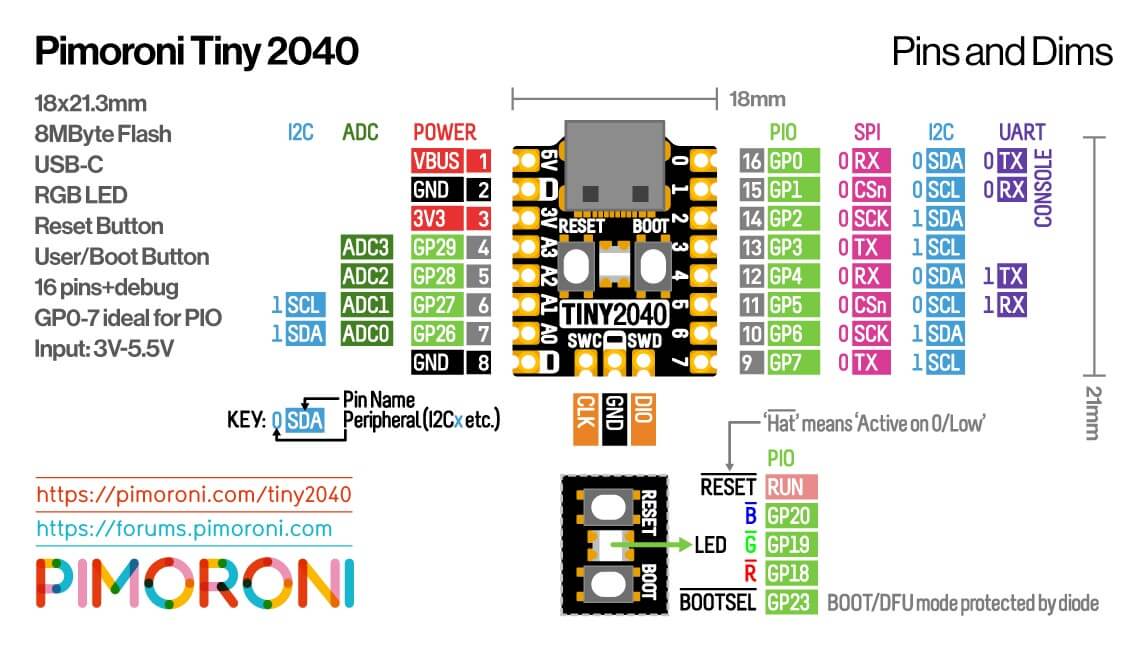Pimoroni Tiny 2040
9.50 د.ك
A postage-stamp-sized RP2040 development board with a USB-C connection and 8MB of flash, perfect for portable projects, wearables, and embedded into devices.
In stock
Description
Note: The Pimoroni Tiny 2040 comes without header pins.
A postage-stamp-sized RP2040 development board with a USB-C connection and 8MB of flash, perfect for portable projects, wearables, and embedded into devices.
While we love the Raspberry Pi Pico we also wanted something smaller and with a bunch more flash on board. Introducing the Tiny 2040 – a teeny tiny powerhouse with the chops to realize truly ambitious projects.
Powered and programmable via USB-C, Tiny 2040 comes with 8MB of QSPI (XiP) flash on board so it can handle projects small and large with ease. The board is designed with castellated pads to allow it to be directly soldered onto a PCB or alternatively, you can use pin headers to hook it up on a breadboard or directly with wires. We’ve even managed to fit in a programmable RGB LED, a reset button, and some clever circuitry that lets you use the boot button as a user-controllable switch.
It’s compatible with firmware built for the Raspberry Pi Pico but offers a reduced number of pins due to its size. You can even run MicroPython on it!
Pimoroni Tiny 2040 Pinout diagram:

Note: The RGB LED is connected to GP18-GP20 and active low (so the on/off state will work in the opposite way to the LED on a Raspberry Pi Pico). You can PWM the pins to dim the LED – check out Tonygo2’s MicroPython example.
Features:
- Powered by RP2040
- ARM Cortex M0+ running at up to 133Mhz
- 264kB of SRAM
- USB-C connector for power, programming, and data transfer
- 8MB of QSPI flash supporting XiP
- User controllable RGB LED
- Twelve IO pins (including four 12-bit ADC channels)
- Switch for basic input (doubles up as DFU select on boot)
- Onboard 3V3 regulator (max regulator current output 300mA)
- Input voltage range 3V – 5.5V
- Dimensions: approx 22.9 x 18.2 x 6mm (L x W x H, including the USB-C port)
RP2040 Specifications:
Raspberry Pi’s RP2040 microcontroller is a dual-core ARM Cortex M0+ running at up to 133Mhz. It bundles in 264kB of SRAM, 30 multifunction GPIO pins (including a four-channel 12-bit ADC), a heap of standard peripherals (I2C, SPI, UART, PWM, clocks, etc), and USB support.
One very exciting feature of RP2040 is the programmable IOs which allow you to execute custom programs that can manipulate GPIO pins and transfer data between peripherals – they can offload tasks that require high data transfer rates or precise timing that traditionally would have required a lot of heavy lifting from the CPU.

- 1st Microcontroller Silicon designed by Raspberry Pi (Raspberry Pi Silicon)
- Proven with Raspberry Pi Pico
- Dual-Core, 32-bit ARM Cortex M0+ Processor
- Flexible clock, configurable max to 133MHz
- On-chip 264KB of SRAM
- Support up to 16MB of external Flash (QSPI)
- 12 Channels of DMA (Direct Memory Access)
- Ready with USB 1.1 PHY, supports Host and Device
- Connected to the USB port and it will appear as USB Mass Storage by default, no driver is needed
- Supports MicroPython, CircuitPython, C, C++, C alike in Arduino IDE Programming Language
- Drag and Drop Program loading method, just like moving file in Windows Explorer
- Peripheral rich:
- 30 GPIO (4 reserves for QSPI interface to external Flash IC)
- 26 multifunction 3.3V General Purpose I/O (GPIO)A postage-stamp-sized RP2040 development board with a USB-C connection and 8MB of flash, perfect for portable projects, wearables, and embedded into devices.
- 23 GPIO are digital-only
- 5 x 12-bit ADC capable of 500Ksps, Analog to Digital Converter
- 4 x ADC extended to GPIO
- 1 x ADC tied to an internal temperature sensor
- 2 x UART (Universal Asynchronous Receiver/Transmitter)
- 2 x SPI (Serial Peripheral Interface)
- 2 x I2C (Inter IC)
- 16 x PWM (Pulse Width Modulation)
- 1 x Timer with 4 alarms
- 1 x Real Time Counter
- 2 x Programmable IO (PIO) blocks that can emulate high-speed interfaces such as SD card or VGA
- 30 GPIO (4 reserves for QSPI interface to external Flash IC)
- 3-pin ARM Serial Wire Debug (SWD) port
- Accelerated floating-point libraries on-chip
Packing List:
- 1 x Pimoroni Tiny 2040
Resources:
- CircuitPython firmware for Tiny 2040, Tiny 2040 by Pimoroni
- Getting started with CircuitPython, Adafruit Tutorial
- Eagle CAD part, GitHub
- RP2040 Datasheet, pdf file







